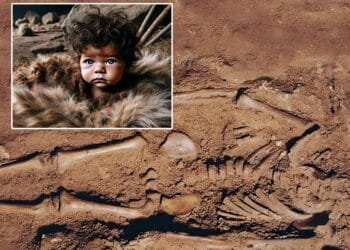Archaeologists have discovered a monumental labyrinthine structure at the summit of Papoura Hill, near Kastelli, Crete. The finding, made during preparations for a new airport, reveals a monumental labyrinthine structure unlike anything previously seen in Minoan archaeology.
The structure, dating back to the Minoan period between 2000 and 1700 BCE, just before or at the start of the palaeopalatial Minoan era, is distinguished by its circular design. The Minoan civilization, known for its advanced architecture, vibrant art, and being Europe’s first known civilization, thrived on Crete from around 3100 BCE to 1100 BCE.
The newly discovered structure spans approximately 48 meters in diameter and covers an area of about 1800 square meters. It consists of eight concentric stone rings converging on a central circular building. This central building, identified as Zone A, has a diameter of 15 meters and is subdivided into four quadrants. Surrounding it is Zone B, featuring radial walls that create smaller interconnected spaces, giving the structure a labyrinthine appearance. The site also includes two potential main entrances located on the southwest and northwest sides.
Initial findings suggest that the structure was not residential but likely served a community or ceremonial purpose. Archaeologists have found a significant number of animal bones, indicating ritualistic use, possibly involving food and wine consumption and offerings. This indicates that the building may have been used periodically for specific events.
The construction’s meticulous design and scale suggest a highly organized central administration with considerable resources and expertise. The structure’s uniqueness in Crete, with parallels drawn to early Bronze Age architecture in the Middle East and proto-Hellenic buildings in mainland Greece, highlights its significance. According to the Greek Ministry of Culture, “The structure does not have an exact parallel with other buildings of the same period on Crete.”
To preserve the monument, the radar installation planned for the new airport will be relocated. The Hellenic Civil Aviation Authority will prepare a new study for the radar location, ensuring that the airport project proceeds smoothly while protecting the archaeological site. Minister of Culture Lina Mendoni expressed, “This is a unique find of great interest. There are solutions so that the archaeological research of the monument is completed and it is absolutely protected.”
The Minoan civilization, renowned for its trade networks, art, and early writing systems like Cretan hieroglyphic and Linear A, reached its peak around 1600 BCE. The new find aligns with the Middle Minoan I-II periods, a time when the first palaces were built.
The excavation at Papoura Hill is part of a broader effort by the Ephorate of Antiquities of Heraklion, under a Memorandum of Cooperation between the Ministry of Culture and the Ministry of Transport and Infrastructure. More than 35 archaeological sites have been investigated as part of this project.




























